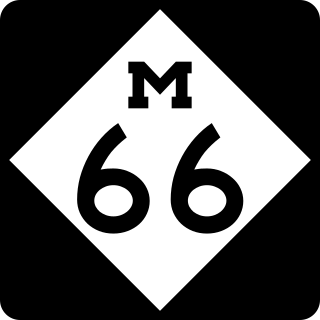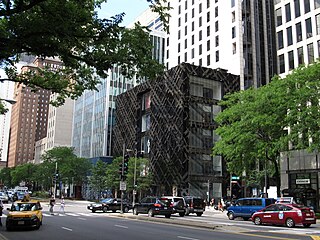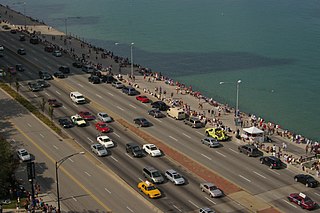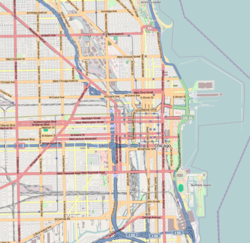
The Chicago River is a system of rivers and canals with a combined length of 156 miles (251 km) that runs through the city of Chicago, including its center. Though not especially long, the river is notable because it is one of the reasons for Chicago's geographic importance: the related Chicago Portage is a link between the Great Lakes and the Mississippi River Basin, and ultimately the Gulf of Mexico.

Grant Park is a large urban park in the Loop community area of Chicago, Illinois. Located within the city's central business district, the 319-acre (1.29 km2) park's features include Millennium Park, Buckingham Fountain, the Art Institute of Chicago, and the Museum Campus.

The Loop is Chicago's central business district and one of the city's 77 municipally recognized community areas. Located at the center of downtown Chicago on the shores of Lake Michigan, it is the second-largest business district in North America after Midtown Manhattan. The headquarters and regional offices of several global and national businesses, retail establishments, restaurants, hotels, and theaters–as well as many of Chicago's most famous attractions–are located in the Loop. The neighborhood also hosts Chicago's City Hall, the seat of Cook County, offices of other levels of government, and several foreign consulates. The intersection of State Street and Madison Street in the Loop is the origin point for the address system on Chicago's street grid.

U.S. Route 45 is a major north-south United States highway and a border-to-border route, from Lake Superior to the Gulf of Mexico. A sign at the highway's northern terminus notes the total distance as 1,297 miles (2,087 km).

U.S. Route 41, also U.S. Highway 41 (US 41), is a major north–south United States Numbered Highway that runs from Miami, Florida, to the Upper Peninsula of Michigan. Until 1949, the part in southern Florida, from Naples to Miami, was US 94. The highway's southern terminus is in the Brickell neighborhood of Downtown Miami at an intersection with Brickell Avenue (US 1), and its northern terminus is east of Copper Harbor, Michigan, at a modest cul-de-sac near Fort Wilkins Historic State Park at the tip of the Keweenaw Peninsula. US 41 is closely paralleled by Interstate 75 (I-75) from Naples, Florida, all the way through Georgia to Chattanooga, Tennessee.

M-66 is a north–south state trunkline highway on the Lower Peninsula of the US state of Michigan. It runs from the Indiana state line in the south to Charlevoix in the north. M-66 is the only state highway to run the north–south distance of the Lower Peninsula. It starts as a continuation of State Road 9 (SR 9), which provides access to the Indiana Toll Road. The total length is approximately 272.9 miles (439.2 km), which includes almost 3.4 miles (5.5 km) of freeway between Interstate 94 (I-94) and downtown Battle Creek designated as I-194. A section of the highway immediately south of I-94 is an expressway, a type of divided limited-access highway, while the section along I-194 is a full freeway; otherwise M-66 is a two-lane rural highway. Two sections are listed on the National Highway System.

Michigan Avenue is a north-south street in Chicago that runs at 100 east on the Chicago grid. The northern end of the street is at DuSable Lake Shore Drive on the shore of Lake Michigan in the Gold Coast Historic District. The street's southern terminus is at Sibley Boulevard in the southern suburb of Dolton, but like many other Chicago streets, it exists in several disjointed segments.

Lake Shore Drive is a semi-limited access expressway that runs alongside the shoreline of Lake Michigan and its adjacent parkland and beaches in Chicago, Illinois. Except for the portion north of Foster Avenue, the Drive is designated part of U.S. Highway 41. A portion of the highway on the Outer Drive Bridge and its bridge approaches is multilevel.

Wrigley Square is a public square located in the northwest section of Millennium Park in the Historic Michigan Boulevard District of the Loop area of Chicago in Cook County, Illinois, United States. The square is located at the southeast corner of the intersection of East Randolph Street and North Michigan Avenue. It contains the Millennium Monument, a nearly full-sized replica of the semicircle of paired Roman Doric-style columns that originally sat in this area of Grant Park, near Michigan Avenue and Randolph Street, between 1917 and 1953. The square also contains a large lawn and a public fountain.

Jackson Park is a 551.5-acre (223.2 ha) urban park on the shore of Lake Michigan on the South Side of Chicago. Straddling the Hyde Park, Woodlawn, and South Shore neighborhoods, the park was designed in 1871 by Frederick Law Olmsted and Calvert Vaux and remodeled in 1893 to serve as the site of the World's Columbian Exposition. It is one of the largest and most historically significant parks in the city, and many of the park's features are mementos of the fair—including the Garden of the Phoenix, the Statue of TheRepublic, and the Museum of Science and Industry.

Parks in Chicago include open spaces and facilities, developed and managed by the Chicago Park District. The City of Chicago devotes 8.5% of its total land acreage to parkland, which ranked it 13th among high-density population cities in the United States in 2012. Since the 1830s, the official motto of Chicago has been Urbs in horto, Latin for "City in a garden" for its commitment to parkland. In addition to serving residents, a number of these parks also double as tourist destinations, most notably Lincoln Park, Chicago's largest park, visited by over 20 million people each year, is one of the most visited parks in the United States. Notable architects, artists and landscape architects have contributed to the 570 parks, including Daniel Burnham, Frederick Law Olmsted, Jens Jensen, Dwight Perkins, Frank Gehry, and Lorado Taft.

U.S. Route 66 was a United States Numbered Highway in Illinois that connected St. Louis, Missouri, and Chicago, Illinois. The historic Route 66, the Mother Road or Main Street of America, took long distance automobile travelers from Chicago to Southern California. The highway had previously been Illinois Route 4 and the road has now been largely replaced with Interstate 55 (I-55). Parts of the road still carry traffic and six separate portions of the roadbed have been listed on the National Register of Historic Places.

Promontory Point is a man-made peninsula jutting into Lake Michigan. It is located in Chicago's Burnham Park. The Point was constructed from landfill and by the late 1930s was protected by a seawall or revetment. The revetment was designed and constructed by Chicago Park District engineers and consists of limestone blocks arranged in a series of four steps leading to a promenade.

Fountain of Time, or simply Time, is a sculpture by Lorado Taft, measuring 126 feet 10 inches (38.66 m) in length, situated at the western edge of the Midway Plaisance within Washington Park in Chicago, Illinois, in the United States. The sculpture is inspired by Henry Austin Dobson's poem "Paradox of Time". Its 100 figures passing before Father Time were created as a monument to the 100 years of peace between the United States and the United Kingdom following the Treaty of Ghent in 1814. Father Time faces the 100 from across a water basin. The fountain's water was turned on in 1920, and the sculpture was dedicated in 1922. It is a contributing structure to the Washington Park United States Registered Historic District, which is a National Register of Historic Places listing.

U.S. Route 41 (US 41) in the U.S. state of Illinois runs north from the Indiana border beneath the Chicago Skyway on Indianapolis Boulevard to the Wisconsin border north of the northern terminus of the Tri-State Tollway with Interstate 94. It is the only north–south U.S. Route to travel through a significant portion of the city of Chicago, carrying Lake Shore Drive through the central portion of the city along the lakefront. US 41 in Illinois is 64.81 miles (104.30 km) in length.

The Historic Michigan Boulevard District is a historic district in the Loop community area of Chicago in Cook County, Illinois, United States encompassing Michigan Avenue between 11th or Roosevelt Road, depending on the source, and Randolph Streets and named after the nearby Lake Michigan. It was designated a Chicago Landmark on February 27, 2002. The district includes numerous significant buildings on Michigan Avenue facing Grant Park. This section of Michigan Avenue includes the eastern terminus of U.S. Route 66. The district is one of the world's best known one-sided streets rivalling Fifth Avenue in New York City and Edinburgh's Princes Street. It lies immediately south of the Michigan–Wacker Historic District and east of the Loop Retail Historic District.

Fountain of the Great Lakes, or Spirit of the Great Lakes Fountain, is an allegorical sculpture and fountain by Lorado Taft. The bronze artwork, created between 1907 and 1913, depicts five women arranged so that the fountains waterfall recalls the waterflow through the five Great Lakes of North America. In the Great Lakes, the waterflow begins in Lake Superior at 600 feet (180 m) above sea level and continues eastward through each lake until it reaches Lake Ontario. The Fountain is one of Taft's best known works. It is located in the public South McCormick Memorial Court of the Art Institute of Chicago, in the Chicago Loop.

There are currently eight business routes of Interstate 94 (I-94) in the US state of Michigan. These business routes connect I-94 to the downtown business districts of neighboring cities. Seven of the eight routes are business loops which bear the Business Loop I-94 designation while one is a business spur that bears the Business Spur I-94. These loops are former routings of I-94's two predecessors in Michigan: US Highway 12 (US 12) or US 25. The westernmost BL I-94 runs through the twin cities of Benton Harbor and St. Joseph along the former routing of US 12 and US 31/US 33 that now includes a section of the Lake Michigan Circle Tour in the state. The loops in Kalamazoo, Battle Creek, Marshall, Albion, and Jackson were also formerly segments of US 12 which were later designated as separate version of Business US Highway 12 through their respective cities before becoming BL I-94s in 1960. The BL I-94 in Kalamazoo was converted into BS I-94 in 2019. The route of the business loop through Ann Arbor was previously US 12 and then later M-14 before receiving its current moniker. The BL I-94 through Port Huron was previously US 25 and then Business US Highway 25.

The Latona Fountain in the Gardens of Versailles lies in the Latona Basin between the Palace of Versailles and the Grand Canal. On the top tier, there is a statue of the goddess Latona, mother of the sun and moon gods. The fountain operates three times a week during the high season.

Ida B. Wells Drive is a major east–west street in downtown Chicago, Illinois, in the United States. It runs east from the Jane Byrne Interchange, where it meets Interstate 90 (I-90), I-94 and I-290. At Wells Street, Ida B. Wells Drive continues as a surface street past State Street and Michigan Avenue, until ending at Columbus Drive in Grant Park in front of the Buckingham Fountain. In 2018, the editorial board of The New York Times praised the Chicago City Council's renaming of the street to honor the journalist and civil rights activist Ida B. Wells.
































